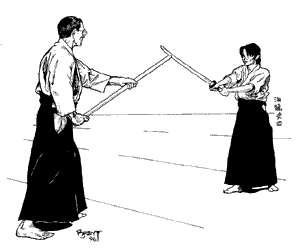| |
The features of Japanese Martial Arts can be summed up in
some characteristcs : weighty, stable, simple with much implications and meditational.
 SIMPLE : Japanese emphasize one punch, one kick and one swing of a
sword so strong and fast that they need no more motion to kill their enemy.
So every motion in japanese martial arts is very simple with no excrescence
unnecessary, but powerful at once. Owing to this simpleness its motions are
not continuous but intermittent. They make each motion then pause and do another,
especially in Karate. Of course, you can find some continuous movement like
in Aikido, but its movement still contains simpleness. Compare it with some
of Chinese martial arts. Even if the motion of Aikido look continuous it is
very simple comparatively. I mean simpleness not only in its continuity but
in whole characteristics. This simpleness is both merit and defect of Japanese
martial arts. We can get easier in erasing unnecessary surfacial features
to reach the essence of martial arts, TAEKWNODO, which has no shape. But TAEKWONDO
is in its essence very changeful and dynamic, so that the simplicity of a
motion may restrict our understanding.
SIMPLE : Japanese emphasize one punch, one kick and one swing of a
sword so strong and fast that they need no more motion to kill their enemy.
So every motion in japanese martial arts is very simple with no excrescence
unnecessary, but powerful at once. Owing to this simpleness its motions are
not continuous but intermittent. They make each motion then pause and do another,
especially in Karate. Of course, you can find some continuous movement like
in Aikido, but its movement still contains simpleness. Compare it with some
of Chinese martial arts. Even if the motion of Aikido look continuous it is
very simple comparatively. I mean simpleness not only in its continuity but
in whole characteristics. This simpleness is both merit and defect of Japanese
martial arts. We can get easier in erasing unnecessary surfacial features
to reach the essence of martial arts, TAEKWNODO, which has no shape. But TAEKWONDO
is in its essence very changeful and dynamic, so that the simplicity of a
motion may restrict our understanding. 
 STABLE : Japanese martial arts in general are stable compared with
another oriental martial arts. They emphasize the firm stable poses and simple
skilles in practice and the patience in spirit which is necessary to endure
the boringness and hardness in such a stable poses. The stableness of Japanese
martial arts requres much pain in both mind and body, sometimes unnecessary.
This feature leads us to the significancy in Japanese martial arts.
STABLE : Japanese martial arts in general are stable compared with
another oriental martial arts. They emphasize the firm stable poses and simple
skilles in practice and the patience in spirit which is necessary to endure
the boringness and hardness in such a stable poses. The stableness of Japanese
martial arts requres much pain in both mind and body, sometimes unnecessary.
This feature leads us to the significancy in Japanese martial arts.
 SIGNIFICANT : Japanese have such a disposition as to put really much
implication and meaning even in a simple and trival motion and ceremony. Take,
for example, the ceremony of tea. This is a kind of getting a tea or a coffee
when considered in its practical aspect. But they put more implication than
that. They want to find as much implication on the life and inner spirit even
as they cannot explain extinctively. This disposition can be found in martial
arts too. They interprets every motion as a significant. This interpretations
also follows the rule of simplicity. For example, the motions of Karate, which
was taught by the people Kaya(so it is called "Kayate>Karate"),
was consititute of skills powerful when interpreted as continuous motions,
but they were divided into each simple movements by
Japanese with some ideological interpretation. The Grand Master Lee, Kwang
Hee can interprete the original practical meaning of each movement in Karate
Poomsae(Kata). Any way, many people agree that the significancy is distinctive
feature of Japanese martial arts.
SIGNIFICANT : Japanese have such a disposition as to put really much
implication and meaning even in a simple and trival motion and ceremony. Take,
for example, the ceremony of tea. This is a kind of getting a tea or a coffee
when considered in its practical aspect. But they put more implication than
that. They want to find as much implication on the life and inner spirit even
as they cannot explain extinctively. This disposition can be found in martial
arts too. They interprets every motion as a significant. This interpretations
also follows the rule of simplicity. For example, the motions of Karate, which
was taught by the people Kaya(so it is called "Kayate>Karate"),
was consititute of skills powerful when interpreted as continuous motions,
but they were divided into each simple movements by
Japanese with some ideological interpretation. The Grand Master Lee, Kwang
Hee can interprete the original practical meaning of each movement in Karate
Poomsae(Kata). Any way, many people agree that the significancy is distinctive
feature of Japanese martial arts.
| |
Understanding the fundamentals
of Japanese Martial arts
- Spiritual aspects: Samurai Spirit and its Shade
|
|
|
|